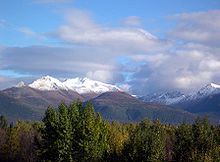- Climate of Anchorage, Alaska
-
The climate of Anchorage, Alaska is a subarctic climate (Köppen climate classification Dfc) due to its short, cool summers. Average daytime summer temperatures range from approximately 55 to 78 degrees Fahrenheit (13 to 26 degrees Celsius); average daytime winter temperatures are about 5 to 30 degrees (-15 to -1 degrees Celsius). Anchorage has a frost-free growing season that averages slightly over 100 days.
Average January low and high temperatures at Ted Stevens Anchorage International Airport (PANC) are 9 °F/22 °F (-13 °C/-5 °C) with an average winter snowfall of 70.6 inches (179 cm).[1]
The weather on any given day and indeed for entire seasons can be very unpredictable. Some winters feature several feet of snow and cold temperatures, while others, just a foot or two of snow and frequent thaws, which put dangerous ice on the streets.
On March 17, 2002, a record snow storm dumped 26.7 inches (68 cm) of snow on the Anchorage area in 24 hours,[2] closing schools for the next two days. The storm broke the city record for the most snowfall in a single day. The storm, which started the evening of March 16, easily surpassed the old record of 15.6 inches (40 cm) recorded on 28 December and 29 December 1955. On March 17, 22 inches (56 cm) were measured by the National Weather Service[2][3], topping the old record of 15.6 inches (40 cm) set on December 29, 1955.[3]
Anchorage Climate chart (explanation) J F M A M J J A S O N D 0.72290.726120.734180.544290.755391.162471.765522.963492.955412.140281.128161.12411Average max. and min. temperatures in °F Precipitation totals in inches Metric conversion J F M A M J J A S O N D 17-6-1319-3-11171-8137-218134271784318117417973135534-228-2-927-4-12Average max. and min. temperatures in °C Precipitation totals in mm The 1954-1955 winter had 132.8 inches (337 cm), which made it the snowiest winter on record while the least snowiest winter of record was 1957-1958 when 30.4 inches (77 cm) of snow fell.[3] The coldest temperature ever recorded at the original weather station located at Merrill Field on the East end of 5th Avenue was −38 °F (−39 °C) on February 3, 1947.[4]
Due to its proximity to active volcanoes, ash hazards are a significant, though infrequent, occurrence. The most recent notable incident was an August, 1992 eruption of Mt. Spurr, which is located 78 miles west of the city.[5] The eruption deposited about 3 mm of volcanic ash on the city. The clean-up of ash resulted in excessive demands for water and caused major problems for the Anchorage Water and Wastewater Utility.
Summers are typically mild (although cool compared to the contiguous US and even interior Alaska), though it can rain frequently. Average July low and high temperatures are 52 °F/66 °F (11 °C/19 °C) and the hottest reading ever recorded was 86 °F (30 °C) on June 25, 1953.[4] The average annual precipitation at the airport is 16.08 inches (408 mm).[6]
Because of Anchorage's latitude, summer days are very long and winter daylight hours are very short. Anchorage is often cloudy during the winter, which decreases the amount of sunlight experienced by residents.[7]
Climate data for Anchorage (Anchorage Int'l) Month Jan Feb Mar Apr May Jun Jul Aug Sep Oct Nov Dec Year Record high °F (°C) 56
(13)57
(14)56
(13)72
(22)82
(28)92
(33)84
(29)85
(29)73
(23)64
(18)62
(17)53
(12)92
(33)Average high °F (°C) 22.2
(−5.4)25.8
(−3.4)33.6
(0.9)43.9
(6.6)54.9
(12.7)62.3
(16.8)65.3
(18.5)63.3
(17.4)55.0
(12.8)40.0
(4.4)27.7
(−2.4)23.7
(−4.6)43.1 Average low °F (°C) 9.3
(−12.6)11.7
(−11.3)18.2
(−7.7)28.7
(−1.8)38.9
(3.8)47.0
(8.3)51.5
(10.8)49.4
(9.7)41.4
(5.2)28.3
(−2.1)15.9
(−8.9)11.4
(−11.4)29.3
(−1.5)Record low °F (°C) −35
(−37.2)−38
(−38.9)−24
(−31.1)−15
(−26.1)1
(−17.2)29
(−1.7)34
(1)31
(−0.6)19
(−7.2)−6
(−21.1)−21
(−29.4)−36
(−37.8)−38
(−38.9)Precipitation inches (mm) .68
(17.3).74
(18.8).65
(16.5).52
(13.2).70
(18)1.06
(26.9)1.70
(43.2)2.93
(74.4)2.87
(72.9)2.09
(53.1)1.09
(27.7)1.05
(26.7)16.08
(408.4)Snowfall inches (cm) 7.4
(18.8)9.8
(24.9)8.7
(22.1)3.9
(9.9).1
(0.3)0
(0)0
(0)0
(0).2
(0.5)7.3
(18.5)9.6
(24.4)12.6
(32)59.6
(151.4)Avg. precipitation days (≥ 0.01 in) 8.1 7.2 6.8 5.5 7.0 8.2 11.3 13.8 14.5 12.3 9.3 11.1 115.1 Avg. snowy days (≥ 0.1 in) 7.0 5.9 5.8 3.4 .2 0 0 0 .2 4.3 7.0 8.8 42.6 Sunshine hours 83.7 121.5 195.3 234.0 288.3 276.0 251.1 204.6 159.0 117.8 81.0 52.7 2,065.0 Source no. 1: NOAA (normals, 1971−2000) [8] Source no. 2: HKO (sun only, 1961−1990) [9], Weather.com (extreme temps) [10] References
- ^ "NOWData - NOAA Online Weather Data". National Weather Service. http://www.nws.noaa.gov/climate/xmacis.php?wfo=pafc. Retrieved 2011-05-22.
- ^ a b "PAFC March 2002 Precipitation". National Weather Service. 2002-03. http://pafc.arh.noaa.gov/climate.php?climstn=PAFC&climmo=3&climyr=2002. Retrieved 2011-05-22.
- ^ a b c "Anchorage Snowfall Records". National Weather Service. http://pafc.arh.noaa.gov/climate/climPage.php?pId=snow. Retrieved 2011-05-22.
- ^ a b "Anchorage Temperature Records". National Weather Service. http://pafc.arh.noaa.gov/climate/climPage.php?pId=temp. Retrieved 2011-05-22.
- ^ "Mt. Spurr's 1992 Eruptions". Alaska Volcano Observatory. http://www.avo.alaska.edu/archives/spurreos/spurreos.php. Retrieved 2008-11-26.
- ^ "Anchorage Precipitation Records". National Weather Service. http://pafc.arh.noaa.gov/climate/climPage.php?pId=precip. Retrieved 2011-05-22.
- ^ For November, December, and January, average monthly percent possible sunshine (the hours of direct sunlight experienced, divided by the possible hours of sunlight for the location) is below 35%. See http://climate.umn.edu/cawap/mpr/jargon.htm for an explanation of the concept "percent possible sunlight." Data from Data Through 2005 Average Percent Possible Sunshine. National Climatic Data Center. Last accessed November 20, 2006.
- ^ "NCDC: U.S. Climate Normals" (PDF). National Oceanic and Atmospheric Administration. http://cdo.ncdc.noaa.gov/climatenormals/clim20/ak/500280.pdf. Retrieved 2010-03-31.
- ^ "Climatological Normals of Anchorage". Hong Kong Observatory. http://www.weather.gov.hk/wxinfo/climat/world/eng/n_america/us/Anchorage_e.htm. Retrieved 2010-05-19.
- ^ "Average Weather for Anchorage, AK - Temperature and Precipitation". The Weather Channel. http://www.weather.com/outlook/travel/businesstraveler/wxclimatology/monthly/USAK0012. Retrieved 2009-10-07.
Categories:- Geography of Anchorage, Alaska
- Climate by city
Wikimedia Foundation. 2010.

